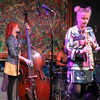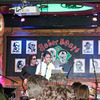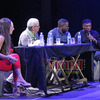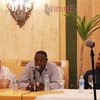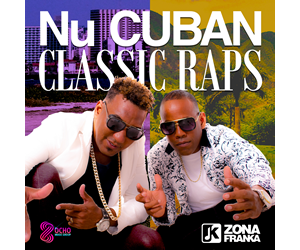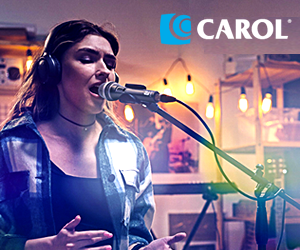Indice - Table of contents
New Stuff[hide]
Reportes: From The St... : Jazz Plaza ...
Fotos: Tom Ehrlich : Irakere 50th Annivers...
Fotos: Tom Ehrlich : Irakere
Resenas: Joey Altruda Presents: El Gran ...
Reportes: From The St... : Cubadisco 2...
Timbapedia: 09. Interviews -... : Carlos del Pino ...
Fotos: Tom Ehrlich : 2023 Monterey Jazz Fe...
Fotos: Tom Ehrlich : 2023 Monterey Jazz Fe...
Fotos: Tom Ehrlich : 2023 Monterey Jazz Fe...
Fotos: Tom Ehrlich : 2023 Monterey Jazz Fe...
Grupos: Tirso Duarte
Grupos: Tirso Duarte : Discography
Grupos: Charanga Habaner... : 8. El bla bla bla
Grupos: Pupy y los que S... : Tirso Duarte
Photos of the Day [hide]
SpanishEnglishDiscography - El puente - Somos lo que hay
Somos lo que hay
somos lo que hay
lo que se vende como pan caliente
lo que prefiere y pide la gente
lo que se agota en el mercado
lo que se escucha en todos lados
somos lo máximo
[audio example 20] [El puente version]
Somos lo que hay was the anthem of the mid-90's Timba revolution -- as if a nation of impoverished Cubans woke up one morning, looked in the mirror, and collectively realized that they were the hippest, funkiest, most happening thing on Earth -- lo máximo ... lo más grande.
Somos lo que hay became such a universal phrase and sentiment that it was paraphrased by Juan Formell for the Team Cuba theme song:
somos lo que hay,
lo que baila La Habana,
la timba cubana,
la pachanga y la sofocación.
[audio example 21] [From a May 1998 live performance of Team Cuba, which included Manolín and several bandmembers. The lead singer here is Issac Delgado.]
The coro was also appropriated by David Calzado, who had already recorded four of Manolín's songs, for a Charanga Habanera coro in the live version of Riki Rikón. The audio example, by the way, is from "Live in the USA", the first Ciocan Music live Timba CD, recorded at Rancho Gaspar only a few months before "El puente".
somos los que somos,
lo que se venden como el caramelo,
lo que prefieren por el mundo entero,
el comentario de la gente,
lo que se usa en el ambiente
puro voltaje, somos la 220
[audio example 22] [from Charanga Habanera's "Live in the USA", Ciocan Music]
Even the Cuban government started to appropriate the phrase as a propaganda slogan until Manolín followed it up with an equally moving piece of music and an equally catchy lyrical hook:
Mami
hay que vivir para ver
los tiempos cambian tú va(s) a ver
ya tengo amigos en Miami
[audio example 23] [from De buena fe]
This song, Que le llegue la mano, perhaps the most poignant of the many emotional climaxes of De buena fe, was really the first El puente -- and the seed from which all subsequent clashes with the Cuban government grew. It was only played live for a brief period in Cuba and has not to my knowledge been played live in Miami.
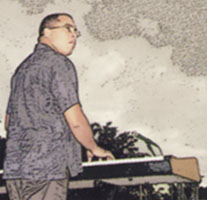 Somos lo que hay has been played in Miami many times, and the El puente version is the funkiest I've ever heard -- featuring some of the most exciting use of the wah-wah pedal since Jimi Hendrix' "All Along the Watchtower". Shown here in Peter Maiden's photo from the 2001 San Francisco Jazz Festival, Hamed Barroso has created a new type of tumbao -- a mixture of explosive hard rock melodicism, funky James Brown "scratch" comping, y mucha clave -- and it fits Manolín's music like a glove. Manolín, Issac, and especially Paulito FG have made successful use of the electric guitar for some time, but Barroso is breaking new ground here. [audio example 24] The more times you listen to the rhythm section in this audio example, the more gems you'll encounter. On the left side of the mix we hear the sonic marriage of one of the most modern and one of the most ancient of the instruments invented by man for the purposes of laying down a groove -- Hamed's Stratocaster and Tomasito's güiro. They sound surprisingly similar and complement each other like the more traditional blend of the campana and contracampana bells on the right side. To the left and right of center in the mix are Chaka's piano and Luis Bu's brassy synth contratumbao, which doesn't enter until after the series of bloques. Tomasito's three congas are panned widely - low, high, middle - from left to right.
Somos lo que hay has been played in Miami many times, and the El puente version is the funkiest I've ever heard -- featuring some of the most exciting use of the wah-wah pedal since Jimi Hendrix' "All Along the Watchtower". Shown here in Peter Maiden's photo from the 2001 San Francisco Jazz Festival, Hamed Barroso has created a new type of tumbao -- a mixture of explosive hard rock melodicism, funky James Brown "scratch" comping, y mucha clave -- and it fits Manolín's music like a glove. Manolín, Issac, and especially Paulito FG have made successful use of the electric guitar for some time, but Barroso is breaking new ground here. [audio example 24] The more times you listen to the rhythm section in this audio example, the more gems you'll encounter. On the left side of the mix we hear the sonic marriage of one of the most modern and one of the most ancient of the instruments invented by man for the purposes of laying down a groove -- Hamed's Stratocaster and Tomasito's güiro. They sound surprisingly similar and complement each other like the more traditional blend of the campana and contracampana bells on the right side. To the left and right of center in the mix are Chaka's piano and Luis Bu's brassy synth contratumbao, which doesn't enter until after the series of bloques. Tomasito's three congas are panned widely - low, high, middle - from left to right.
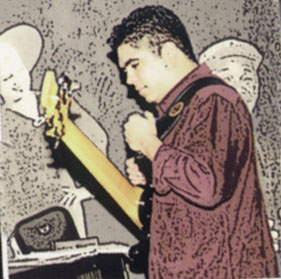 And in the middle is bassist José Armando Gola, known to most simply as "Gola". The credits incorrectly list him as "Andy Gola", but Andy is actually his father. A fascinating bit of Timba trivia is that Manolín's great pianist Chaka actually began his career as a bassist with a Timba band called "Colé, Colé", led by none other than Andy Gola.
And in the middle is bassist José Armando Gola, known to most simply as "Gola". The credits incorrectly list him as "Andy Gola", but Andy is actually his father. A fascinating bit of Timba trivia is that Manolín's great pianist Chaka actually began his career as a bassist with a Timba band called "Colé, Colé", led by none other than Andy Gola.
In any case, Gola began playing with the band in the Spring of 2000 when they went on tour to California. As you might have guessed, your faithful reviewer was present at each show on that tour, but what you'd be less likely to guess is that El Médico de la Salsa was not! Just as that tour began, Manolín decided to return to Cuba, leaving the band in San Francisco to do the tour without him. His brother Lázaro sang lead respectably and the management didn't even realize that the "Salsa Doctor" they were hearing was practicing without a medical degree! And those of us in the know weren't letting on.
My introduction to Timba had come while watching Gola's predecessor, Victoriano Nápoles. With his beaming smile and compact, punchy James Jamerson-esque tone, Nápoles immediately became one of my favorite musicians, so it took me a while to warm up to Gola, but with his playing on El puente he's won me over completely. The sound of his six string bass is so deep that many PA systems seem to have trouble with it and it can sound muddy compared to Nápoles' crystal clear, round tones, but in the El puente mix, it sounds great, and very funky. Listen to the bass entrance on the same audio example [audio example 24]. If you compare the original studio versions to their El puente counterparts, you can hear all sorts of funky little licks that Gola adds which fit perfectly with the band's new more guitar-flavored groove.










